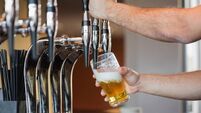Obesity fears over study into teens’ eating habits
Cakes and fizzy drinks top the list, new research on the eating habits of Irish adolescents has found. However, many use some of the money to buy credit for their mobile phones.
The research, undertaken by Dr Alan Collins and Dr Mary McCarthy at the Department of Food Business and Development in University College Cork (UCC), and assisted by Dr Karen Harrington, a senior community dietician with the Health Service Executive Southern Region, will fuel concern about the rise in teenage obesity.
They studied the school day eating habits of almost 1,500 students in seven non-health promoting schools in Cork City and County.
The researchers found that if food was available at school - either energy dense foods known as top shelf food and drinks (TSFDs) or healthier options - at home preparation was seen as not as necessary.
They found that taste is the most important motive for adolescents when choosing a food or drink product - if the product was not tasty it was unlikely to be consumed.
The researchers also focussed on the TSFDs eating habits of female adolescents. They found that if they got lunch money, and if TSFDs were available in school, they ate more TSFDs.
However, consumption of TSFDs was also higher where students could leave the school at lunchtime.
The price and value of TSFDs also affected consumption levels.
“This suggests that TSFDs were perceived to represent better value and that, if one wished to eat more cheaply, one selected food products from the top shelf,” the report said. Money left over could be used for other things, like mobile phone top-ups.
Peer pressure also affected TSFD consumption.
“Left to their own devices, adolescents whose food choice decisions were influenced by their peers will consume TSFDs more frequently,” the report said.
“On a more positive note, the importance the student placed on a healthy physique and natural food ingredients were found to be negatively associated with TSFD consumption.”
“The study suggests that improvements in healthier eating may be achieved but will require both a reshaping of adolescents’ food choice motives and a reconsideration of the positive constraints on eating behaviour by guardians and school management.”
The researchers are trying to source funding to carry out more research in the area. The research is being replicated in the US and plans are in place for studies in Britain and Norway.













